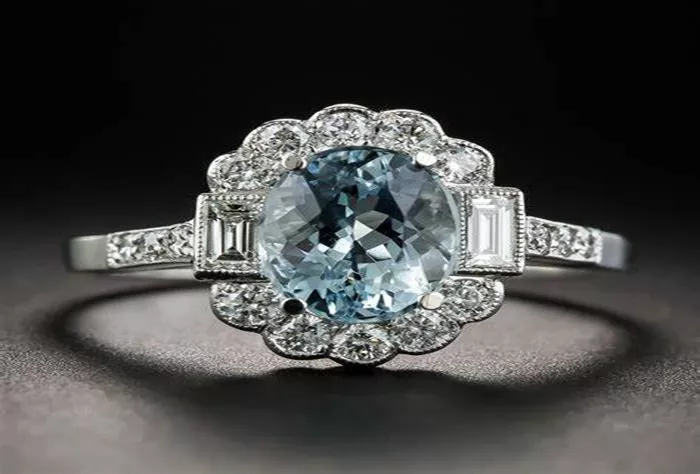The Edwardian aquamarine ring is a stunning piece of jewelry that captures the elegance and sophistication of the early 20th century. This ring is a beautiful representation of the Edwardian era, a time when jewelry design was delicate, intricate, and full of romantic details. The aquamarine, with its soft blue hue, was a favorite gemstone during this period, symbolizing tranquility and timeless beauty.
The Edwardian Era: A Time of Luxury and Refinement
The Edwardian era, named after King Edward VII of England, lasted from 1901 to 1910, though its influence on jewelry design extended into the 1920s. This was a time of luxury and refinement, and jewelry from this period reflects that. Edwardian rings are known for their light, airy designs, often featuring intricate metalwork, milgrain detailing, and delicate engravings. The use of platinum was common, as it allowed for fine, lace-like patterns that would have been difficult to achieve with heavier metals like gold.
Design Characteristics of Edwardian Aquamarine Rings
An Edwardian aquamarine ring typically features a central aquamarine stone, often cut in an oval or cushion shape, surrounded by smaller diamonds or other gemstones. The setting is usually open and airy, with filigree work that adds to the ring’s delicate appearance. The milgrain detailing—tiny beads of metal along the edges—gives the ring a soft, finished look. Many Edwardian rings also feature scrollwork or floral motifs, which were popular during this romantic period.
The Significance of Aquamarine in Edwardian Jewelry
Aquamarine, the birthstone for March, was highly prized during the Edwardian era for its serene blue color, which was associated with the sea and the sky. The gemstone was believed to bring calmness and protection to the wearer, making it a meaningful choice for engagement rings and sentimental jewelry. The light blue hue of aquamarine complemented the platinum and diamond settings perfectly, creating a harmonious and elegant look.
Exquisite Craftsmanship of Edwardian Jewelers
One of the defining characteristics of an Edwardian aquamarine ring is the craftsmanship. Jewelers during this time paid great attention to detail, often handcrafting each piece with precision. The filigree work, for example, required immense skill, as thin strands of platinum were carefully twisted and soldered to create intricate patterns. The milgrain detailing was also done by hand, with tiny metal beads applied one by one to enhance the ring’s edges. This level of craftsmanship is rarely seen in modern jewelry, making Edwardian pieces highly sought after by collectors.
How to Identify an Authentic Edwardian Aquamarine Ring
When examining an Edwardian aquamarine ring, it is important to look for signs of authenticity. Genuine Edwardian rings will have hallmarks or maker’s marks on the inside of the band, indicating the metal’s purity and the jeweler’s identity. Platinum was the preferred metal, so most authentic pieces will be made from this material. The craftsmanship should be flawless, with no visible soldering marks or rough edges. The filigree work should be delicate and precise, and the milgrain detailing should be evenly applied.
Factors That Determine the Value of an Edwardian Aquamarine Ring
The value of an Edwardian aquamarine ring depends on several factors, including the quality of the aquamarine, the presence of diamonds or other gemstones, the intricacy of the design, and the overall condition of the piece. High-quality aquamarines with a clear, even blue color are more valuable than stones with visible inclusions or uneven coloring. The cut of the aquamarine also matters—older cuts like the cushion or old European cut are more desirable in antique pieces. The diamonds used in Edwardian rings are usually old mine or rose cuts, which have a softer sparkle compared to modern brilliant cuts.
Caring for Your Edwardian Aquamarine Ring
Caring for an Edwardian aquamarine ring requires special attention due to its age and delicate design. Platinum is a durable metal, but the filigree work can be fragile. It is best to avoid wearing the ring during activities that could damage it, such as gardening or sports. Cleaning should be done gently with a soft brush and mild soap, avoiding harsh chemicals that could harm the metal or gemstones. Storing the ring in a soft cloth or a padded jewelry box will help prevent scratches and other damage.
Why Edwardian Aquamarine Rings Remain Timeless Treasures
The appeal of an Edwardian aquamarine ring lies in its timeless beauty and historical significance. Each ring tells a story of craftsmanship, elegance, and romance from a bygone era. Whether worn as an engagement ring, a statement piece, or a collector’s item, this type of jewelry continues to captivate with its delicate details and serene blue gemstone. The combination of aquamarine and platinum creates a look that is both sophisticated and ethereal, making it a perfect choice for those who appreciate vintage charm.
Collecting Edwardian Aquamarine Rings: A Worthy Investment
Collectors and jewelry enthusiasts often seek out Edwardian aquamarine rings for their rarity and unique designs. Because these rings were handmade, no two are exactly alike, adding to their allure. The intricate metalwork and attention to detail make them stand out from modern mass-produced jewelry. For those interested in antique jewelry, an Edwardian aquamarine ring is a wonderful investment, as its value tends to appreciate over time.
Conclusion
In conclusion, the Edwardian aquamarine ring is a masterpiece of jewelry design, representing the elegance and craftsmanship of the early 1900s. Its delicate filigree, milgrain detailing, and serene blue gemstone make it a timeless piece that continues to be admired today. Whether you are a collector, a history enthusiast, or simply someone who loves beautiful jewelry, an Edwardian aquamarine ring is a treasure worth cherishing. Its romantic design and exquisite craftsmanship ensure that it will remain a beloved piece for generations to come.
Related Topics:
- Antique Aquamarine Gold Ring: Value, Identification & Care
- Is Black Tourmaline Heavy or Light?
- Unveiling the History: When Was Black Tourmaline Discovered?


